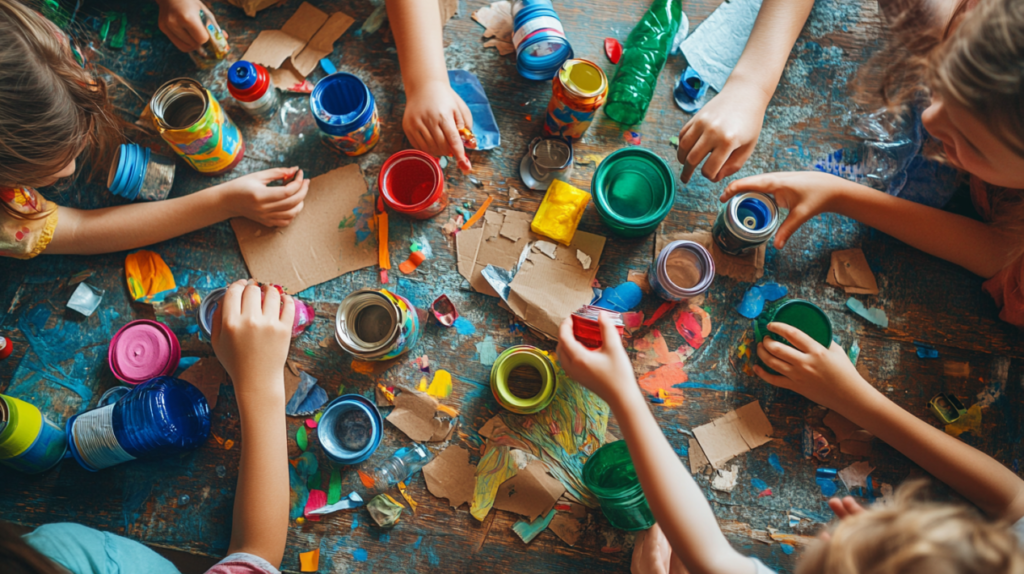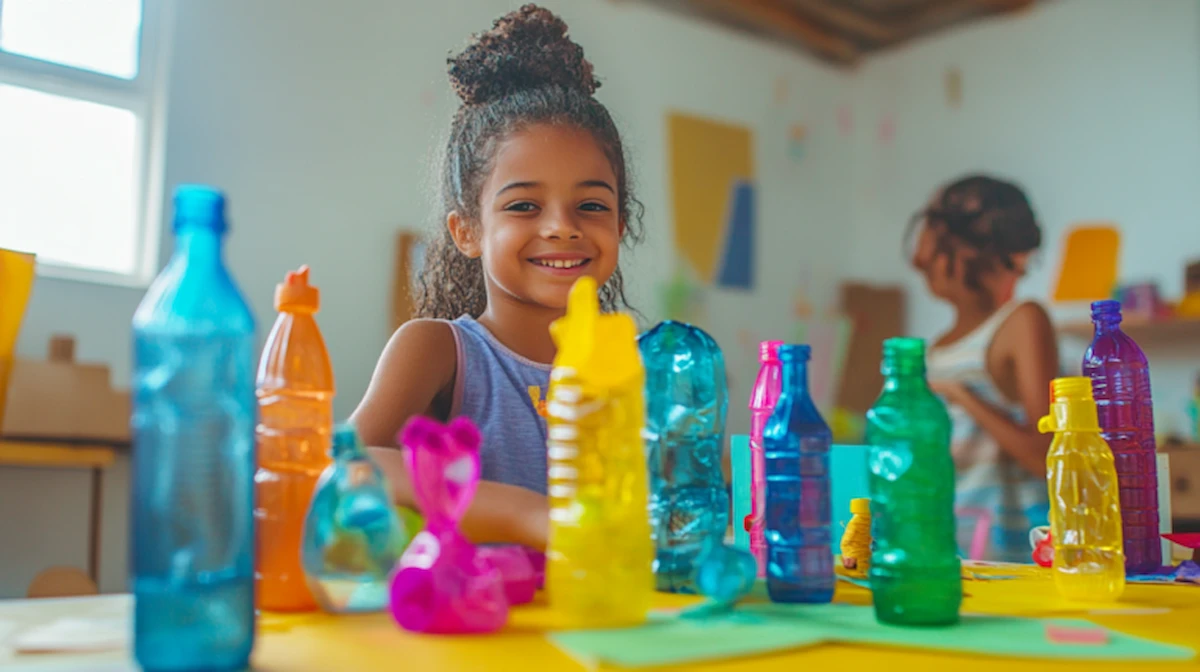Looking for fun and eco-friendly ways to keep your kids engaged and learning at home? Upcycling projects for kids are the perfect combination of creativity, education, and sustainability. These hands-on activities give children the chance to turn ordinary household items into exciting new creations—boosting their imagination while also teaching the importance of reducing waste and protecting the environment.
From transforming empty cardboard boxes into castles or playhouses, to repurposing tin cans into colorful pencil holders, upcycling projects for kids help develop fine motor skills, problem-solving abilities, and artistic expression. Plus, they’re a fantastic way to introduce children to eco-conscious thinking early on, showing them that even the smallest actions—like reusing a bottle cap—can have a positive impact on the planet.
Whether you’re a busy parent looking for meaningful screen-free activities, a teacher planning a classroom project, or just someone who wants to make the most of what you already have at home, these DIY ideas are simple, budget-friendly, and incredibly rewarding. In this post, we’ll explore 10 creative upcycling projects for kids that you can easily try using materials you probably already have around the house.
Get ready to inspire your child’s creativity, strengthen your family bond, and take a step toward a greener lifestyle—all through fun, engaging upcycling projects for kids that make sustainability feel like an adventure!
Why Upcycling Projects for Kids Are Important

In today’s world, where sustainability is more important than ever, upcycling projects for kids offer a valuable opportunity to teach environmental responsibility from a young age. These hands-on activities help children understand how everyday waste can be transformed into something new and useful, reinforcing the idea that small actions can make a big difference.
Beyond environmental benefits, upcycling projects for kids encourage creativity and problem-solving. Whether they’re building a robot from recycled boxes or decorating old jars into colorful organizers, kids learn to think outside the box and explore their imaginations. These projects also improve fine motor skills, coordination, and patience—all while having fun.
Moreover, upcycling projects for kids promote quality time with family. Working together on creative crafts strengthens bonds and creates lasting memories. It’s not just about making something beautiful—it’s about instilling values that last a lifetime. By introducing kids to upcycling early, you’re helping them develop a mindset of sustainability, resourcefulness, and respect for the environment.
Upcycling with Common Household Items

One of the best things about upcycling projects for kids is that you don’t need to buy anything fancy—your home is already full of materials waiting to be transformed! With just a little creativity, everyday household items can become the foundation for fun and educational crafts that kids will love.
Start with something as simple as toilet paper rolls. These cardboard tubes are perfect for creating animals, binoculars, or even race cars. They’re lightweight, easy to paint, and a great way to spark your child’s imagination. Next, look at egg cartons—a classic upcycling tool. Whether they’re turned into colorful caterpillars, mini planters, or sorting trays, they offer countless options for hands-on learning.
Plastic bottles are another fantastic material for upcycling projects for kids. Kids can turn them into bird feeders, rocket ships, or pencil holders. Not only does this reduce plastic waste, but it also teaches kids how to find value in what would normally be thrown away.
Even cardboard boxes can become magical with the right upcycling idea. From dollhouses to pretend kitchens and forts, cardboard lets kids dream big while learning about reusing and repurposing.
By using what you already have at home, upcycling projects for kids become affordable, accessible, and environmentally friendly—all while keeping creativity at the forefront.
Table of Contents
Easy Upcycling Crafts for Preschoolers

When it comes to upcycling projects for kids, preschoolers can join the fun with simple, safe, and colorful crafts that nurture their creativity. These early years are the perfect time to introduce sustainable habits through playful activities that transform ordinary objects into something special.
Start with mason jars—they’re ideal for little hands to decorate. Kids can paint them with bright colors or fill them with buttons, pom-poms, or crayons to create fun and functional storage jars. It’s a great way to teach them about organization while enjoying a craft.
Another fantastic idea is making sock puppets from old, mismatched socks. With some glue, googly eyes, and scraps of fabric, preschoolers can design their own puppet friends. These types of upcycling projects for kids not only reduce waste but also encourage imaginative play.
Paper towel rolls can be turned into telescopes, animals, or even mini musical instruments. These lightweight tubes are easy to handle and offer endless creative possibilities. Similarly, preschoolers can use recycled cardboard to make shapes, puzzles, or backgrounds for their artwork.
These easy upcycling projects for kids are perfect for tiny crafters, promoting fine motor development, environmental awareness, and a love for hands-on learning. Best of all, they require minimal prep and can be done with materials you already have at home.
Creative Weekend Upcycling Projects for Older Kids

Weekends are a great time to dive into more detailed and imaginative upcycling projects for kids, especially for older children who are ready for a challenge. These projects not only keep them entertained but also help develop planning, design, and problem-solving skills—all while reinforcing the importance of sustainability.
One fun weekend idea is creating tin can wind chimes. With a few empty cans, paint, string, and beads, kids can craft colorful wind chimes to hang outside. It’s a rewarding project that combines art, sound, and environmental awareness—all hallmarks of great upcycling projects for kids.
Older kids can also turn old T-shirts into tote bags. With some cutting and tying—no sewing required—they can transform unused clothing into something practical. It’s a stylish way to promote reusing fabric and sparks conversations about reducing textile waste.
Another creative activity is making CD mosaics or wall art. Broken or scratched CDs can be cut into reflective pieces and glued onto cardboard or wooden frames. It’s a beautiful and unique form of recycled art that makes these upcycling projects for kids especially exciting for tweens and preteens.
Lastly, try crafting bookends from bricks or wood scraps. With some paint and imagination, kids can create customized bookends to brighten up their bookshelves. These weekend projects are not only fun but also instill a deeper appreciation for repurposing materials.
By dedicating time on the weekend to upcycling projects for kids, parents can help older children gain independence, learn new skills, and build eco-conscious habits that will stick with them for life.
Tips for Making Upcycling Projects Safe and Fun
While upcycling projects for kids are a fantastic way to promote creativity and sustainability, safety and enjoyment should always come first. By following a few simple tips, you can ensure that each project is both fun and worry-free for your little makers.
First, always use child-friendly tools and materials. When working on upcycling projects for kids, opt for non-toxic glue, washable paints, blunt-edge scissors, and other supplies that are safe for all ages. This allows kids to explore independently while giving parents peace of mind.
Supervision is also key, especially when handling items like glass jars, tin cans, or any material with sharp edges. Turn these moments into learning opportunities by teaching kids the correct way to handle and respect tools, which is a valuable life skill tied into responsible crafting.
Organization can also make a big difference. Prepare a crafting space ahead of time, using trays or containers to keep materials sorted. Not only does this make upcycling projects for kids run more smoothly, but it also teaches kids about cleanliness and order.
To keep things exciting, let kids make creative choices. Offer them a variety of materials and allow their imaginations to guide the project. When children feel ownership of their creations, upcycling projects for kids become more meaningful and memorable.
Finally, make clean-up part of the fun. Sing a song, race to put supplies away, or reward kids for their help. These positive habits encourage responsibility and make crafting something to look forward to.
By combining creativity with safety and a sprinkle of fun, you’ll turn upcycling projects for kids into enriching experiences that spark joy, learning, and a lifelong respect for the environment.
Conclusion: Inspire Young Minds Through Upcycling
Upcycling projects for kids are more than just arts and crafts—they’re powerful tools for teaching creativity, sustainability, and hands-on problem solving. By turning everyday household items into imaginative creations, children learn that they don’t always need new or expensive materials to have fun or make something beautiful.
Throughout this blog post, we’ve explored how upcycling projects for kids can be both educational and entertaining. From simple crafts for preschoolers to more advanced weekend projects for older kids, each activity is a chance to bond as a family while promoting eco-conscious habits that will last a lifetime.
The best part? You don’t need to be an expert crafter to get started. With just a few household materials and a little imagination, you can transform trash into treasure right at your kitchen table. These upcycling activities not only help reduce waste but also empower kids to see the value in everyday objects.
So the next time you’re about to toss something in the recycling bin, pause for a moment—could it be part of your next family craft session? With the right mindset and some fun project ideas, upcycling projects for kids can turn ordinary afternoons into unforgettable moments of learning, laughter, and creativity.


